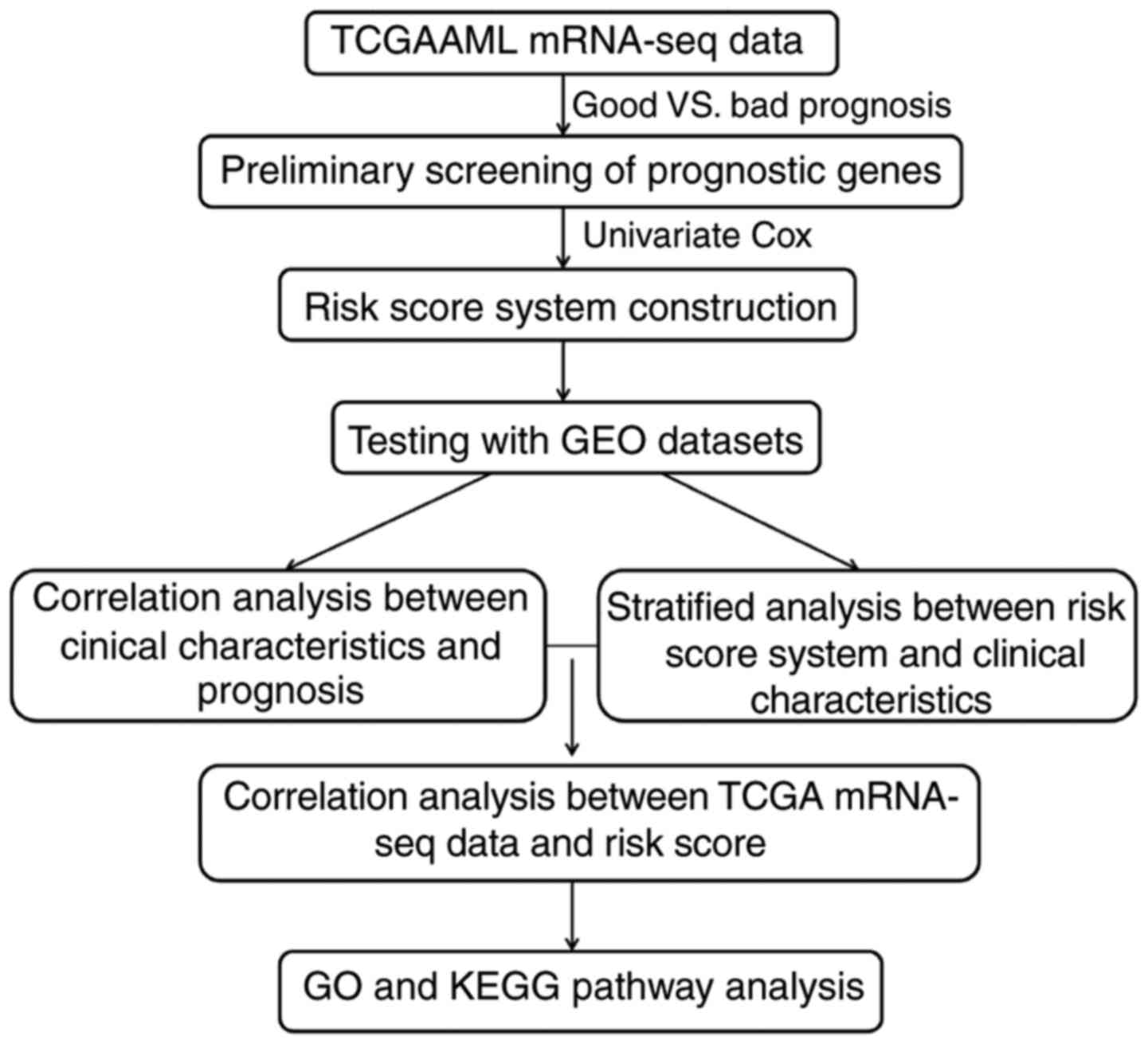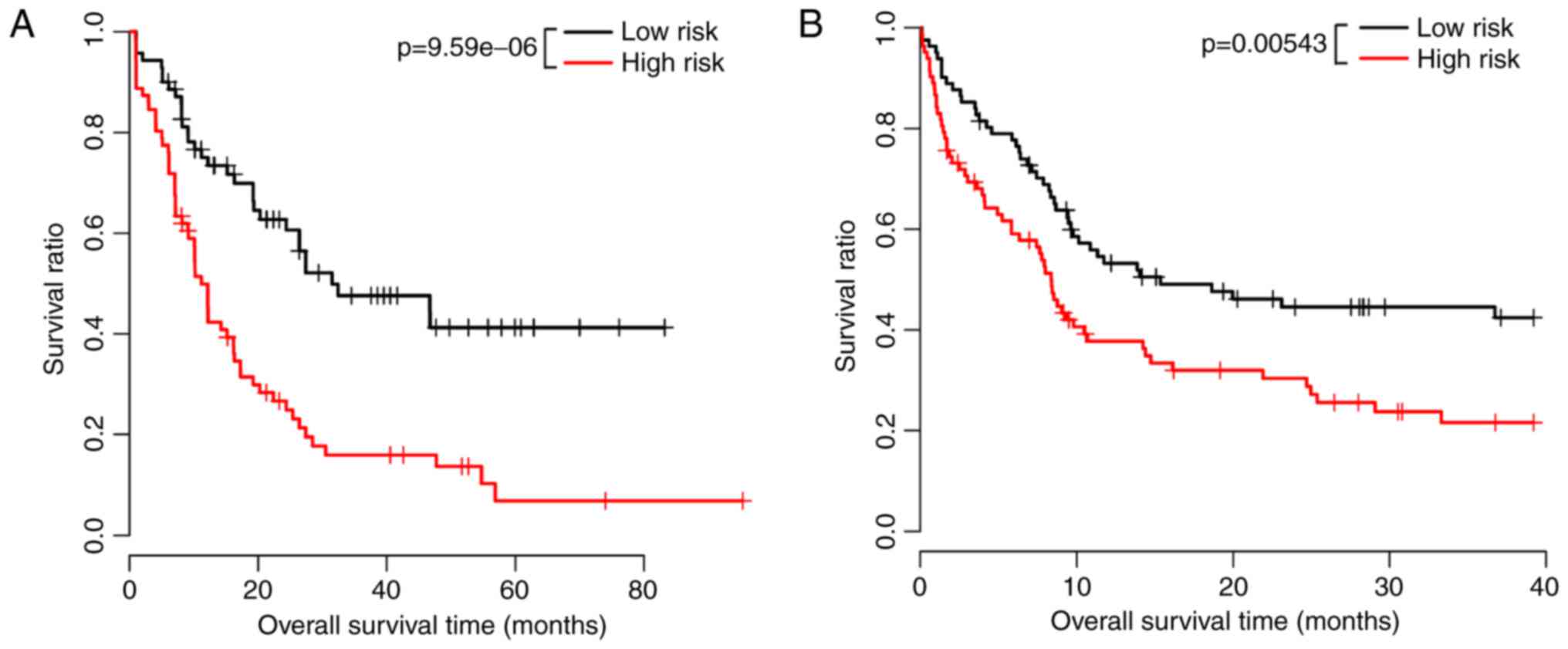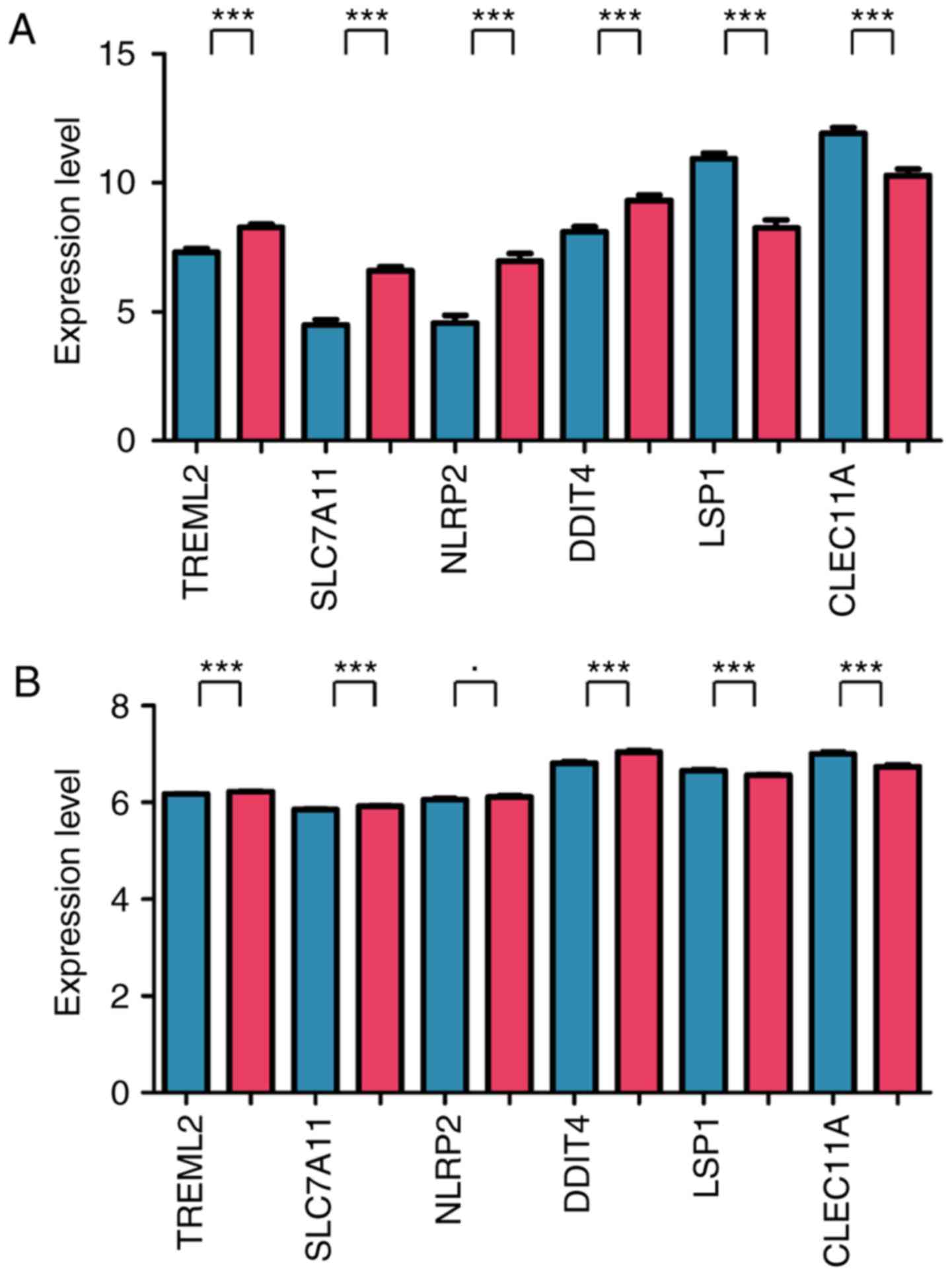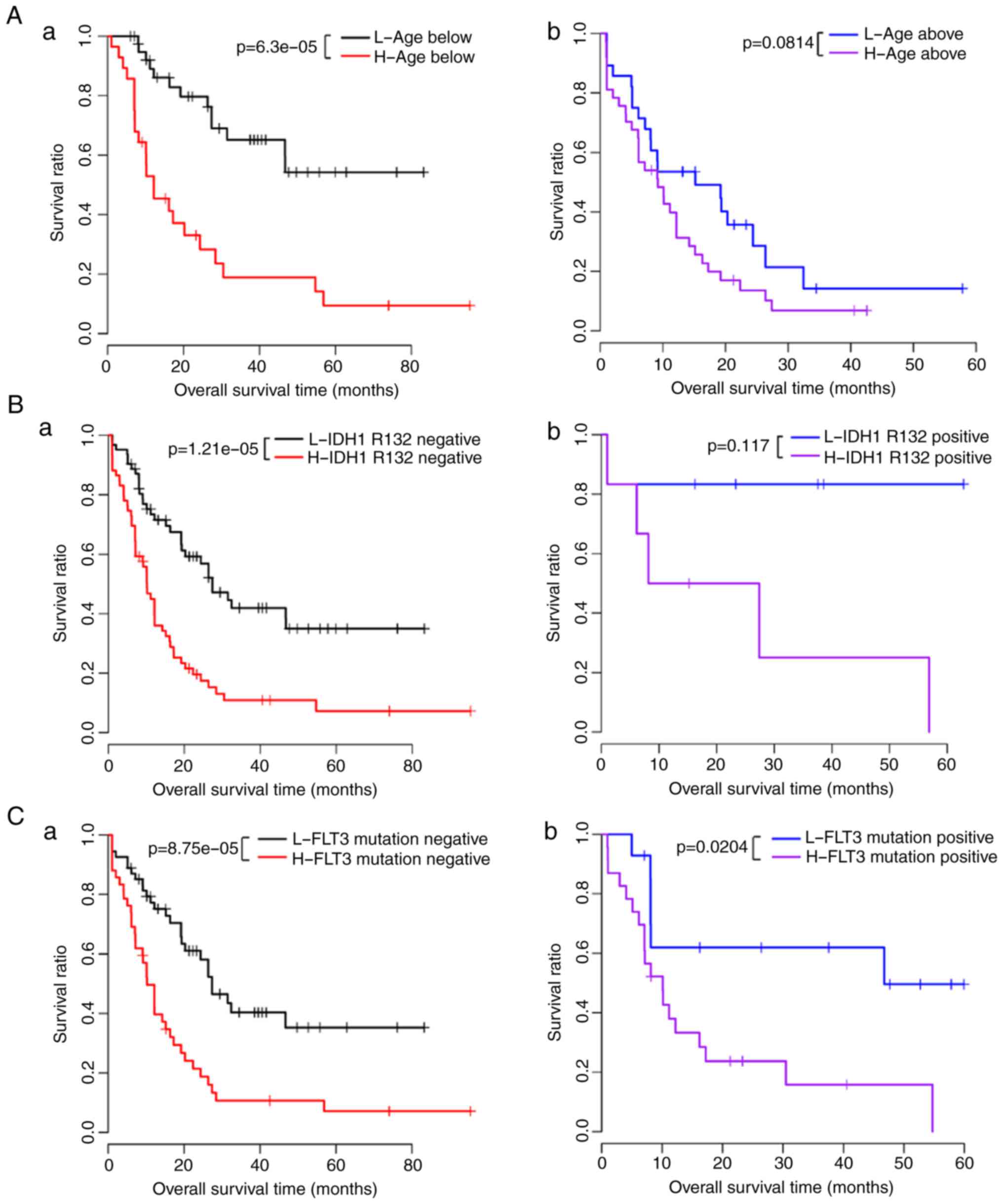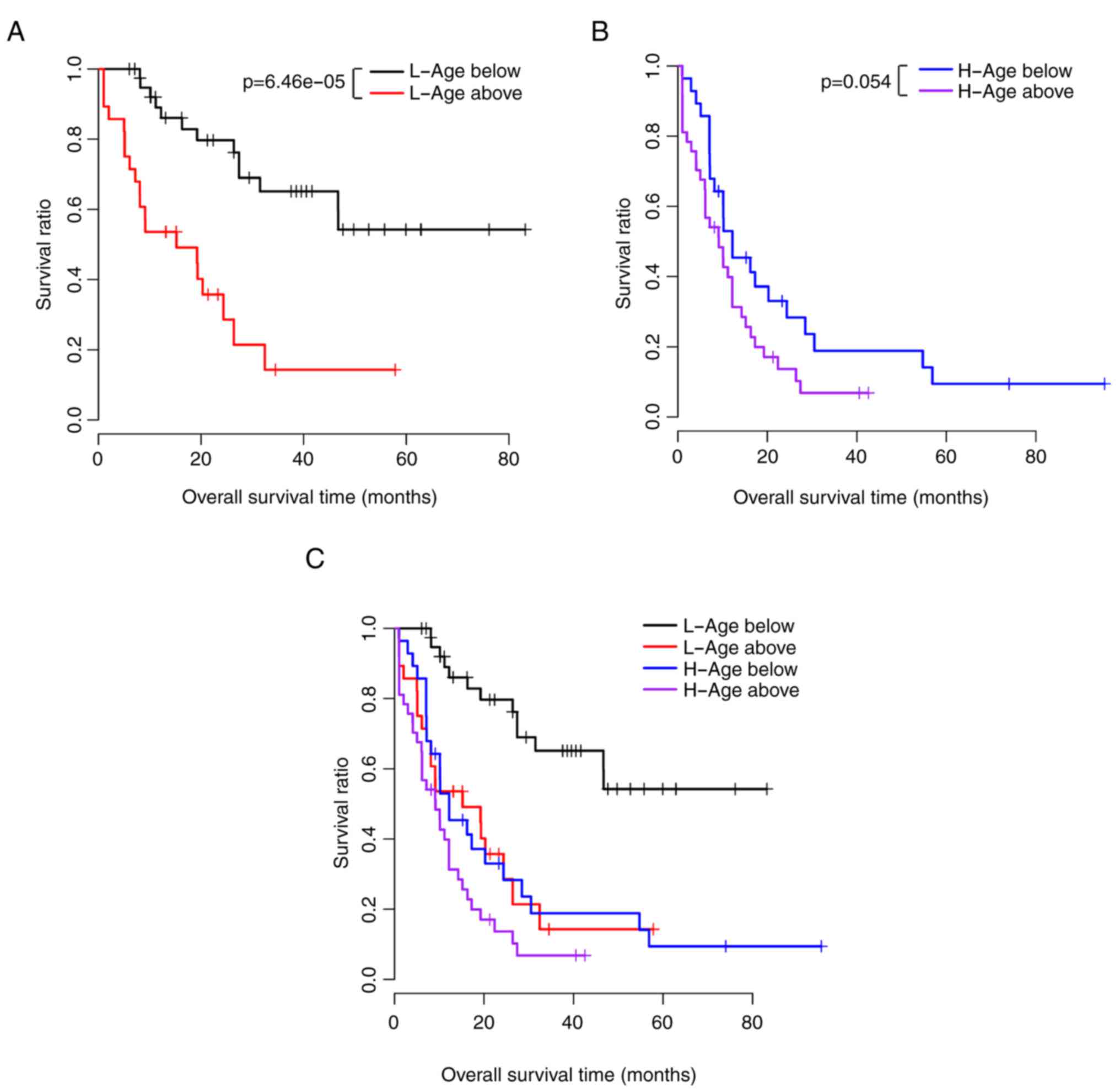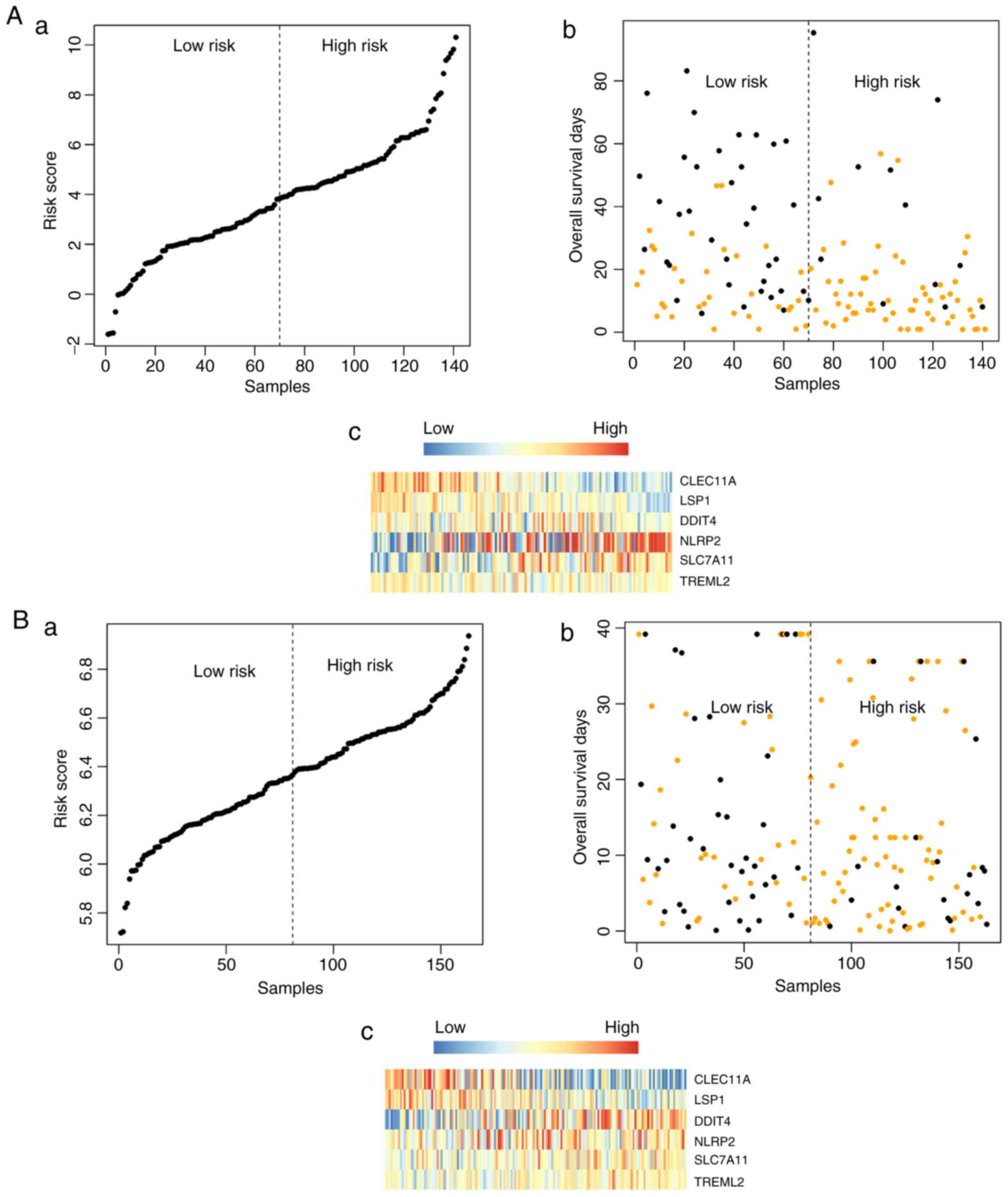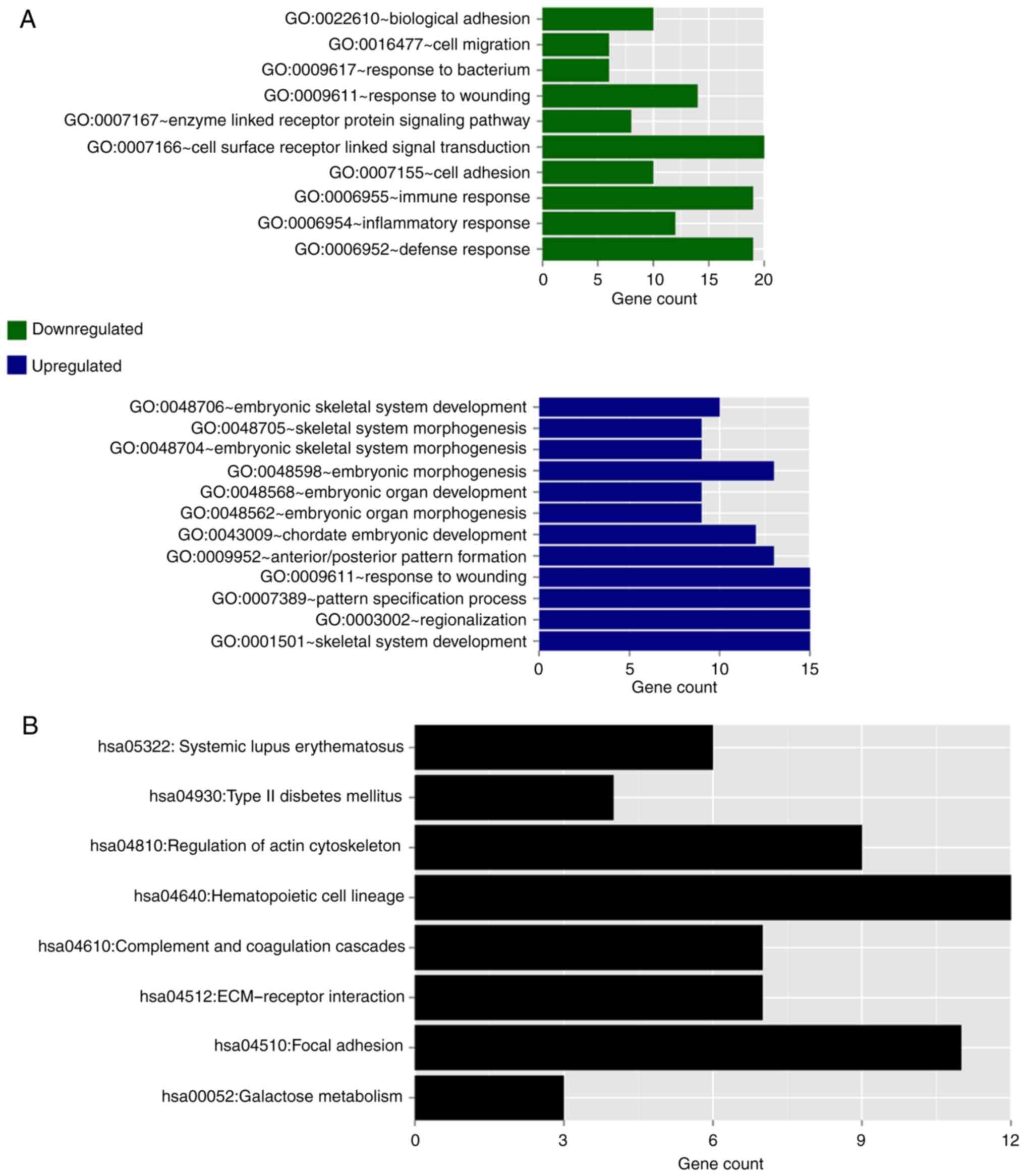A novel scoring system for acute myeloid leukemia risk assessment based on the expression levels of six genes
- Authors:
- Published online on: June 21, 2018 https://doi.org/10.3892/ijmm.2018.3739
- Pages: 1495-1507
-
Copyright: © Zhao et al. This is an open access article distributed under the terms of Creative Commons Attribution License.
Abstract
Introduction
Acute myeloid leukemia (AML) is the most common type of acute leukemia. It is a heterogeneous clonal disorder characterized by an increase in the number of myeloid cells in the marrow and an arrest in their maturation, frequently resulting in hematopoietic insufficiency (1). The annual incidence of AML in the United States in 1999 was ~2.4 per 100,000 individuals, and the prevalence of the condition increased progressively with age to reach a peak of 12.6 per 100,000 individuals in adults aged 65 years or older (1). The incidence of AML has become higher than ever. In 2016, the number of new cases of AML in the United States was 19,950, representing an increase of 6,090 from the number reported in 2013 (2,3).
By contrast, the number of cases of AML-associated mortality in 2016 revealed an increase of only 230 cases, compared with the number of cases of AML-associated mortality in 2013 (2,3). With the ongoing improvements in chemotherapeutic protocols in support therapy, and the development of hematopoietic stem cell transplantation techniques, the prognosis of patients with AML has improved. However, there remain several challenges in the clinical treatment of AML. For example, it was previously reported that 10–20% of patients with AML do not enter remission following their first course of chemotherapy, a number of patients succumb to mortality due to complications of chemotherapy, and >50% of affected patients are expected to eventually relapse with low remission rates and short median survival rates (4,5). Therefore, AML remains one of the most difficult diseases to treat clinically; therefore, the examination of the pathogenesis of AML and methods to effectively prevent the condition have become areas of interest in research.
At present, the pathogenesis of AML remains to be fully elucidated, and it is generally considered to involve multiple mutations of gene loci with numerous mechanisms. Previous studies have identified several prognostic indicators for AML, including age, cytogenetic findings, white blood cell count, and the presence or absence of an antecedent hematologic disorder (e.g., myelodysplasia) (6). Until the 1990s, cytogenetic findings represented the most useful prognostic factor (7,8). However, additional factors associated with the pathogenesis and prognosis of AML have been found, including cell karyotype, micro-ribonucleic acid-155 (9), and gene mutation and expression (10). The aberrant expression of certain specific genes associated with hematopoiesis, bone marrow differentiation and immune stress can significantly affect the chemotherapeutic effects on and the prognosis of AML. For example, the high expression of brain and acute leukemia, cytoplasmic (BAALC) and MN1 has a close association with the poor prognosis of AML (10–13). As the previous prognostic scoring systems that have been used are mainly based on age, cytogenetic findings and white blood cell count, the examination of additional AML-related genes and the establishment of a more effective scoring system based on the expression levels of these genes are of important theoretical and clinical significance.
In order to investigate the possible unknown important pathogenic mechanisms and novel biomarkers of AML, comprehensive bioinformatics analysis methods were used in the present study. The messenger ribonucleic acid sequencing (mRNA-seq) data of patients with AML were downloaded from the Cancer Genome Atlas (TCGA) database, and were integrated with clinical data and survival information to screen out differentially expressed genes (DEGs) associated with AML. A prognostic scoring system was established based on the screened genes and simultaneously validated by a dataset from the Gene Expression Omnibus (GEO) database. The reliability of the novel prognostic scoring system was further validated by performing a correlation analysis between clinical characteristics and prognosis, and stratified analysis between risk assessment and clinical characteristics.
Materials and methods
Data sources
The mRNA‑seq expression profiles of adult patients with AML were downloaded from TCGA database (https://gdc-portal.nci.nih.gov/) on April 10, 2017, having been sequenced on the Illumina HiSeq™ 2000 platform (Illumina, San Diego, CA, USA). In total, there were 200 bone marrow tissue samples from patients with AML, of which 173 had corresponding clinical information barcode numbers. This dataset was used as the training dataset.
For the validation dataset, 'acute myeloid leukemia' and 'human' were used as key words to search the GEO database (https://www.ncbi.nlm.nih.gov/geo) on April 27, 2017. Subsequently, the GSE12417 expression dataset (14) from the GPL96 platform, which contained a total of 163 AML adult bone marrow tissue samples, was selected and downloaded. In the original article of the GSE12417 dataset, the trials were approved by the local institutional review boards of all participating centers, and informed consent was obtained from all patients in accordance with the Declaration of Helsinki (14). The overall analytical process used in the present study is presented in Fig. 1.
Clinical information
The clinical information of the training and validation datasets were received and then sorted, as shown in Table I. Survival information was provided; the overall survival rates were 19.30±19.79 months in the training dataset and 15.12±14 months in the validation dataset, respectively (Table I).
Screening of DEGs
Among the 173 AML samples in the training dataset, 160 had survival and prognosis information. Following the removal of those without clinical information and those with survival rates of <6 months, 141 samples remained for further analysis. Of these, samples with survival rates of <12 months were defined as the poor prognosis group, whereas those with survival rates of >24 months were classified into the good prognosis group. The DEGs of the two groups were examined using the Linear Models for Microarray Data (LIMMA) package (15) of R3.1.0 with a false discovery rate (FDR) threshold of <0.05.
Screening of genes associated with prognosis
For the 141 samples with survival rates of >6 months, univariate Cox regression analysis was used in the survival package of R3.1.0 language (16) to screen for genes significantly correlated with prognosis. P‑values were examined by log‑rank and P≤0.05 was set as the threshold of significant correlation. Multivariate Cox regression was then performed to narrow down the eligible genes associated with prognosis.
Establishment of the risk assessment model
Using the genes obtained in the above analyses, a system of patient risk assessment was established by regression factor-weighted gene expression based on linear combination to acquire the risk values for each patient. That is, each risk value was a linear combination of the mRNA expression values obtained following weighting with regression coefficients. The risk score for each patient was calculated according to the following equation: Risk score = βGENE1 × ExprGENE1 + β GENE2 × ExprGENE2 + ⋯ + βGENEn × ExprGENEn, where β represents the coefficient for each gene obtained from the training set and was used to validate the risk of patients in the validation dataset. The difference in prognosis between the high-risk and low-risk groups (with the risk score median as the break point) was also assessed.
Correlation analysis between risk scores and clinical features
The risk scores of samples in the training set and validation set were calculated according to the aforementioned risk assessment system. Likewise, the samples were divided into high and low risk types with the threshold being the median risk score. Additionally, corresponding clinical features of those samples that were significantly associated with prognosis were analyzed using Kaplan-Meier (KM) survival analysis. Consequently, their correlation analysis was performed by Cox regression, which combined the clinical data and the corresponding samples.
Stratification analysis of clinical features significantly correlated with risk scores
According to the aforementioned available information, stratification analysis was performed on the clinical features significantly associated with high and low risk. The detailed analytical procedure included: i) calculation of the correlation between the expression values of each selected gene and their high or low risk; ii) calculation of the correlation between the high- and low-risk groups with their respective survival prognosis with regard to the same risk condition; and iii) calculation of the correlation between different clinical conditions and survival prognosis with the same risk factor.
Functional analysis of important genes associated with high and low risk
According to the scores calculated by the risk assessment model, the samples were divided into a high risk and low risk group. In the training set, the DEGs were screened using the LIMMA package (15) (FDR<0.05). Subsequently, the genes associated with positive or negative risk were selected on the basis of the correlation coefficient between their expression values and corresponding risk values. Thereafter, their biological functions were analyzed by the Database for Annotation, Visualization, and Integrated Discovery (17) to screen the significantly enriched biological processes and pathways in combination with information from the Gene Ontology (GO; http://www.geneontology.org/) and the Kyoto Encyclopedia of Genes and Genomes (KEGG; http://www.genome.jp/kegg/pathway.html) databases. The cut‑off for the selection of significant categories was P<0.05.
Results
Identification and validation of a six gene prognostic signature
The genes in the training datasets were first filtered according to their expression values, and those with an average expression of <5 were removed. Subsequently, a total of 141 samples were screened out following the exclusion of those with survival rates of <6 months. Among the 141 samples, further grouping was performed to differentiate the samples with good or poor prognosis. Finally, a total of 55 samples from deceased patients with survival rates of <12 months were classified as the poor prognosis group, and 27 patient samples from living patients with survival rates of >24 months were classified as the good prognosis group. The DEGs of the two groups were screened and a total of 206 significant DEGs were screened out.
Subsequently, the prognostic values of the above 206 DEGs were assessed by univariate Cox regression analysis and a total of 162 genes associated with prognosis were screened out. Multivariate Cox regression analysis was then performed for these 162 genes associated with prognosis, and a total of 14 genes significantly associated with prognosis were selected according to the threshold of P<0.01. Finally, the model equations for risk assessment were established based on six genes, specifically NACHT, LRR, and PYD domains-containing protein 2 (NLRP2); triggering receptor expressed on myeloid cells 2 (TREML2); cysteine-glutamate transporter (SLC7A11); DNA damage-inducible transcript 4 protein (DDIT4); lymphocyte-specific protein 1 (LSP1); and C-type lectin domain family 11 member A (CLEC11A) (Table II). The risk scores were determined as follows: Risk score = 1.053 × ExprTREM L2 + 0.426 × ExprSLC7A11 + 0.222 × ExprNLRP2 + 0.548 × E xprDDIT4 + (−0.771) × ExprLSP1 + (−0.396) × ExprCLEC11A
Table IIInformation of six genes based on which the model equations for risk assessment were constructed. |
Validation of the model classification effect
The model equation for risk assessment was used to evaluate the risk of each patient, following which patients in the TCGA training group were divided into high-risk patients and low-risk patients according to the median risk score. Patients in the low-risk group had longer survival rates, compared with those in the high-risk group. In the training dataset, the mean survival rate of 71 samples in the high-risk group was 14.06±14.81 months, whereas that of the 70 samples in the low-risk group was 28.9 6±21.57 months (P=9.59e-06). In the validation dataset, the mean survival rate of 81 samples in the high-risk group was 17.48±7.49 months, whereas that of 82 samples in the low-risk group was 28.24±12.89 months (P=0.00543). The significant association between the expression of the above six genes and the survival information was validated using KM survival curve analysis (Fig. 2A and B).
Expression profile of the six important genes
In the training dataset, the expression values of TREML2, SLC7A11, NLRP and DDIT in the high‑risk group were significantly higher, compared with those in the low-risk group (P<0.005), whereas the expression values of LSP and CLEC11 in the high-risk group were significantly lower, compared with those in the low-risk group (P<0.005) (Fig. 3A). In the validation dataset, the expression trends of five genes were similar to those in the training dataset (P<0.005), with the exception of NLRP2 (0.01≤P<0.05) (Fig. 3B).
Correlation analysis between risk score and clinical features
The clinical features that were significantly associated with prognosis were screened using univariate and multivariate Cox regression analysis and the results showed that, in addition to risk score, which was the independent prognostic factor, age was another factor associated with clinical prognosis (Table III).
Correlation between individual signature genes and risk score
The correlation between the six individual signature genes (TREML2, SLC7A11, NLRP2, DDIT4, LSP and CLEC11A) and risk score model equations were analyzed using univariate Cox regression. As shown in Table IV, five genes, including TREML2, SLC7A11, NLRP2, LSP and CLEC11A, were associated with age (P<0.05) and TREML was also associated with FMS-like tyrosine kinase 3 (FLT3) mutation and nucleophosmin mutation (NPMc) (P<0.05).
Stratification analysis of clinical features significantly correlated with risk scores
The correlations between clinical features and prognosis were analyzed. The results showed that age, FLT3 mutation, isocitrate dehydrogenase (NADP+) 1, cytosolic R132, and NPMc were significantly associated with prognosis (Table V). The KM survival curves of the above four factors in the low-risk and high-risk groups are shown in Fig. 4A–D.
The correlations between different clinical conditions and survival prognosis under the same risk condition were analyzed, and the results showed that age was significantly associated with prognosis under the same risk conditions (Table VI). The KM survival curves of age and prognosis in the low-risk and high-risk groups are shown in Fig. 5A–C. The risk score, overall survival, and the expression values of the six signature genes in the training dataset (Fig. 6Aa-c) and validation dataset (Fig. 6Ba-c) are shown in Fig. 6.
Functional enrichment analysis of genes associated with different prognoses
The DEGs of the high-risk group and low-risk group in the training dataset were screened using LIMMA (15). A total of 309 DEGs were obtained with the criterion of FDR<0.05.
Following correlation analysis between the DEGs and risk value, 111 and 198 DEGs were obtained with expression levels associated with negative or positive risk, respectively. GO function and KEGG pathway enrichment analysis of these DEGs were performed and the results are shown in Fig. 7. The downregulated genes were significantly enriched into 10 GO terms, predominantly associated with cell defense and immune response, whereas the upregu-lated genes were significantly enriched into 12 GO terms, predominantly associated with morphogenesis and development (Fig. 7A). With regard to the KEGG pathways, as no significant pathways were enriched for the upregulated and downregulated genes, respectively, all these genes were combined to show the KEGG pathway enrichment results. These genes were predominantly enriched in eight KEGG pathways: Systemic lupus erythematosus, type 2 diabetes mellitus, regulation of actin cytoskeleton, hematopoietic cell lineage, complement and coagulation cascades, extracellular matrix receptor interaction, focal adhesion, and galactose metabolism (Fig. 7B).
Discussion
Previous studies have identified several prognostic indicators for AML, including age and cytogenetic findings (6). With the development of molecular biology, genetics, and blood cell disease detection technology, increasing factors associated with AML pathogenesis and prognosis have been found, including cell karyotype, and gene mutation and expression (10). In the present study, the large quantities of mRNA-seq data on patients with AML published in TCGA database were used to screen out the significant DEGs associated with AML. As a large-scale cancer genomics project, TCGA database contains substantial cancer genomics data from multiple technical platforms (18). The data are important to cancer research and several studies have demonstrated the value of analyzing networks based on TCGA database (19,20). The present study was performed using 141 patients with AML in the training dataset and 163 patients with AML in the validation dataset. The two datasets provided survival information. According to the survival rates, of the 141 patients with AML in the training dataset, 55 poor prognosis samples were distinguished from 27 good prognosis samples. The aberrant expression of certain specific genes associated with hematopoiesis, bone marrow differentiation, and immune stress can significantly affect the chemotherapeutic effects on and the prognosis of AML, and can become preferred potential candidate genes for investigations, providing assistance in revealing the pathogenesis of AML. In the present study, a total of 206 significantly DEGs were screened out between the poor prognosis group and the good prognosis group. Following univariate Cox regression analysis and multivariate Cox regression analysis, a total of 14 genes significantly associated with prognosis were screened. Finally, six genes (TREML2, SLC7A11, NLRP2, DDIT4, LSP and CLEC11A) were used to establish the model equations for risk assessment. As previous prognostic scoring systems have mainly been based on age, cytogenetic findings and white blood cell count, the establishment of the present prognostic scoring system based on the expression level of AML-related genes has important theoretical and clinical significance, and offers potential for practical application in preclinical and clinical trials.
The six candidate signature genes were divided into two groups according to their expression profiles. The first group included four upregulated genes, which were TREML2, SLC7A11, NLRP and DDIT4. TREM proteins are a family of cell surface receptors, which are involved in diverse cell processes, including inflammation, bone homeostasis, neurological development and coagulation (21). Reportedly, TREML is a potential susceptible gene of osteoporosis. In addition, missense mutation of TREML has a protective effect in the development of Alzheimer's disease (22,23). Based on the present study, it may be associated with the progression of AML.
SLC7A1 is a member of a heterodimeric Na+-independent anionic amino acid transport system, which mediates cysteine-glutamate exchange and thereby regulates intracellular glutathione levels (24,25). In addition, SLC7A1 controls the production of pheomelanin pigment and the proliferation of cultured cells (26), and protects cancer cells of the NCI-60 panel from chemoresistance to numerous compounds (24). The impairment of SLC7A1 can result in the disruption of glutamate homeostasis and lead to a variety of central nervous system disorders, including drug addiction, schizophrenia and neurodegenerative conditions (27). Studies have indicated that the expression of SLC7A1 is markedly increased in breast cancer cell lines and clinical samples (28), and can serve as a predictor of cellular response to L-alanosine- and glutathione-mediated resistance to geldanamycin (24). In gastric cancer, the long non-coding RNA SLC7A11-AS1 can promote tumor growth, and its decreased expression is linked with poor prognosis (29). According to the results of the present study, SLC7A1 may be important in the pathogenesis of AML, yielding a potential target for AML treatment.
NALP genes are characterized by the N-terminal pyrin domain (PYD), and are involved in the activation of caspase-1 by Toll-like receptors and in protein complexes that activate proinflammatory caspases (30). As the most well known member of the NALP gene family, NLRP has been shown to form the core of the inflammasome and respond to numerous pathogen-, danger-, and disease-associated molecular patterns (31–33). Similarly, NALP2 is crucial in inflammation through the regulation of nuclear factor-κB activity, and the PYD of NALP2 can inhibit cell proliferation and tumor growth in human glioblastoma (34). Additionally, NALP has been identified as a predictive biomarker for pregnancy following in vitr fertilization (35). However, there is no direct evidence to date that NALPs are associated with AML.
DDIT4, also known as regulated in development and DNA damage response 1 (REDD1), usually acts as a negative regulator of mechanistic target of rapamycin (mTOR), which regulates a variety of cellular functions including growth, proliferation and autophagy (36,37). Due to its effect on mTOR, which has been associated with aging and linked with diseases including tuberous sclerosis, diabetes and cancer (38), DDIT has attracted increasing interest in clinical studies. The high expression of DDIT has been considered as a prognostic marker in certain malignancies, including AML, breast cancer, and colon, skin and lung cancer (39). This finding supports the reliability of the results of the present study.
The second group included two downregulated genes, LSP and CLEC11A, which are associated with cellular immunity, hematopoiesis and the cytoskeleton. LSP was originally reported as a lymphocyte‑specific actin‑binding protein in murine lymphocytes (40) and was subsequently found in all hematopoietic cells (41). LSP has been reported to regulate cell biology in several types of human cancer, including lymphomas (42), pancreatic cancer (43), breast cancer (44), dermatofibroma (45) and hepatocellular carcinoma (HCC) (46). However, the functions of LSP in AML remain to be elucidated. It has been reported that LSP is downregulated in breast cancer and in patients with HCC, and is considered a risk factor for these two types of cancer (44,46,47). On the basis of previous findings, the downregulation of LSP in the poor prognosis group in the present study indicated that LSP may serve as a prognostic marker and a potential therapeutic target in AML.
CLEC11A, a secreted sulfated glycoprotein expressed in the bone marrow and skeletal tissues, can promote colony formation by human hematopoietic progenitors in culture and assist in maintenance of the adult skeleton (48–51). Previously, CLEC11 was identified as a biomarker for predicting colorectal cancer (52). A previous study confirmed the central role of CLEC11 as a potential regulator of multiple myeloma SET protein in multiple myeloma cell survival and regulation (53). In addition, the plasma level of CLEC11 has been associated with hemoglobin levels and was found to be increased in patients following bone marrow transplantation (54,55). Therefore, it has been considered as a hematopoietic growth factor and novel drug target for myeloma. However, the physiological function of CLEC11 in AML has not been reported.
As SLC7A11, NLRP2, DDIT and LSP have previously been reported to be associated with cancer, it was hypothesized that the six candidate signature genes identified in the present study may be novel factors associated with AML. A correlation analysis between the risk assessment model and clinical features was performed and the results showed that both the risk score and age were prognostic factors, and that age was significantly associated with prognosis under the same risk conditions. The reliability of the model equations for risk assessment was further validated in an independent validation dataset. These investigations aimed to provide an effective tool for the clinical diagnosis of AML, which may assist in elucidating the possible pathogenesis of AML.
Functional annotations of the significant DEGs according to the GO and KEGG databases can provide numerous candidate genes and more information on the pathogenesis of AML. In the present study, GO function analysis of DEGs was performed. The GO terms of the significantly downregulated genes were mainly associated with cell defense and immune response, whereas the GO terms of the significantly upregulated genes were mainly associated with morphogenesis and development, indicating that the immune defense system of the organism was suppressed, with the abnormal amplification of cancer cells predominant. This finding was consistent with the characterization of AML (1). Subsequently, KEGG pathway analysis was performed on the 20 significant characteristic factors, and the results showed that these genes were mainly involved in eight KEGG pathways. The top three significant KEGG pathways were hematopoietic cell lineage, focal adhesion, and regulation of actin cytoskeleton, which are all associated with the abnormal amplification of hemocytes. For example, the 'hematopoietic cell lineage' pathway is important in the processes of hematopoiesis and immune response (56), whereas the 'focal adhesion' pathway is associated with another blood disease, macrothrombocytopenia (57). The results of the present study may provide clues for further clarifying the pathogenesis of AML. However, there were several limitations in the present study. For example, the predictive capability of the model has not been confirmed by direct experiments. In addition, the expression of the six important genes (TREML2, SLC7A11, NALP., DDIT4, LSP and CLEC11A) and their functions in AML require further validation in experiments in vitr and in vivo. Additionally, the survival rates of different individuals in the two datasets were different, which may influence the accuracy of the analysis. Therefore, further analyses are required to elucidate the mechanisms underlying the processes of tumorigenesis and the development of AML.
In conclusion, the present study provided a credible risk assessment model for AML prognosis based on a comprehensive bioinformatics analysis of six candidate genes using data from two independent datasets. All six genes were significantly associated with the diagnosis of AML and may be potential prognostic biomarkers.
Acknowledgments
The authors would like to thank those providing linguistic assistance during the preparation of this manuscript.
Funding
No funding was received.
Availability of data and materials
The datasets used and/or analysed during the current study are available from the corresponding author on reasonable request.
Authors' contributions
HW conceived and designed the study. XZ performed data analyses and wrote the manuscript. YL performed data analyses and revised the manuscript. All authors read and approved the final manuscript.
Ethics approval and consent to participate
In the original article of the GSE12417 dataset, the trials were approved by the local institutional review boards of all participating centers, and informed consent was obtained from all patients in accordance with the Declaration of Helsinki.
Patient consent for publication
Not applicable.
Competing interests
The authors declare that they have no competing interests.
References
|
Löwenberg B, Downing JR and Burnett A: Acute myeloid leukemia. N Engl J Med. 1999:1051–1062. 1999. View Article : Google Scholar | |
|
Siegel R, Naishadham D and Jemal A: Cancer statistics, 2013. CA Cancer J Clin. 63:11–30. 2013. View Article : Google Scholar : PubMed/NCBI | |
|
Siegel RL, Miller KD and Jemal A: Cancer statistics, 2016. CA Cancer J Clin. 66:7–30. 2016. View Article : Google Scholar : PubMed/NCBI | |
|
Coombs C, Tavakkoli M and Tallman M: Acute promyelocytic leukemia: Where did we start, where are we now, and the future. Blood Cancer J. 5:e3042015. View Article : Google Scholar : PubMed/NCBI | |
|
Tallman MS, Gilliland DG and Rowe JM: Drug therapy for acute myeloid leukemia. Blood. 106:1154–1163. 2005. View Article : Google Scholar : PubMed/NCBI | |
|
Löwenberg B: Prognostic factors in acute myeloid leukaemia. Best Pract Res Clin Haematol. 14:65–75. 2001. View Article : Google Scholar : PubMed/NCBI | |
|
Bloomfield CD, Lawrence D, Byrd JC, Carroll A, Pettenati MJ, Tantravahi R, Patil SR, Davey FR, Berg DT, Schiffer CA, et al: Frequency of prolonged remission duration after high-dose cytarabine intensification in acute myeloid leukemia varies by cytogenetic subtype. Cancer Res. 58:4173–4179. 1998.PubMed/NCBI | |
|
Grimwade D, Walker H, Oliver F, Wheatley K, Harrison C, Harrison G, Rees J, Hann I, Stevens R, Burnett A, et al: The importance of diagnostic cytogenetics on outcome in AML: Analysis of 1,612 patients entered into the MRC AML 10 trial The medical research council adult and children's Leukaemia working parties. Blood. 92:2322–2333. 1998.PubMed/NCBI | |
|
Yan W, Xu L, Sun Z, Lin Y, Zhang W, Chen J, Hu S and Shen B: MicroRNA biomarker identification for pediatric acute myeloid leukemia based on a novel bioinformatics model. Oncotarget. 6:26424–26436. 2015. View Article : Google Scholar : PubMed/NCBI | |
|
Metzeler KH, Dufour A, Benthaus T, Hummel M, Sauerland MC, Heinecke A, Berdel WE, Büchner T, Wörmann B, Mansmann U, et al: ER expression is an independent prognostic factor and allows refined risk stratification in cytogenetically normal acute myeloid leukemia: A comprehensive analysis of ERG, MN1, and BAALC transcript levels using oligonucleotide microarrays. J Clin Oncol. 27:5031–5038. 2009. View Article : Google Scholar : PubMed/NCBI | |
|
Aref S, Al Khodary T, Zeed TA, El Sadiek A, El Menshawy N and Al Ashery R: The prognostic relevance of BAALC and ERG expression levels in cytogenetically normal pediatric acute myeloid leukemia. Indian J Hematol Blood Transfus. 31:21–28. 2015. View Article : Google Scholar | |
|
Guo X, Shi P, Chen F, Zha J, Liu B, Li R, Dong H, Zheng H and Xu B: Low MDR1 and BAALC expression identifies a new subgroup of intermediate cytogenetic risk acute myeloid leukemia with a favorable outcome. Blood Cells Mol Dis. 53:144–148. 2014. View Article : Google Scholar : PubMed/NCBI | |
|
Xiang L, Li M, Liu Y, Cen J, Chen Z, Zhen X, Xie X, Cao X and Gu W: The clinical characteristics and prognostic significance of MN gene and MN1-associated microRNA expression in adult patients with de novo acute myeloid leukemia. Ann Hematol. 92:1063–1069. 2013. View Article : Google Scholar : PubMed/NCBI | |
|
Metzeler KH, Hummel M, Bloomfield CD, Spiekermann K, Braess J, Sauerland MC, Heinecke A, Radmacher M, Marcucci G, Whitman SP, et al: An 86-probe-set gene-expression signature predicts survival in cytogenetically normal acute myeloid leukemia. Blood. 112:4193–4201. 2008. View Article : Google Scholar : PubMed/NCBI | |
|
Ritchie ME, Phipson B, Wu D, Hu Y, Law CW, Shi W and Smyth GK: Limma powers differential expression analyses for RNA-sequencing and microarray studies. Nucleic Acids Res. 43:e472015. View Article : Google Scholar : PubMed/NCBI | |
|
Wang P, Wang Y, Hang B, Zou X and Mao JH: A novel gene expression-based prognostic scoring system to predict survival in gastric cancer. Oncotarget. 7:55343–55351. 2016.PubMed/NCBI | |
|
Huang da W, Sherman BT and Lempicki RA: Systematic and integrative analysis of large gene lists using DAVID bioinformatics resources. Nat Protoc. 4:44–57. 2009. View Article : Google Scholar : PubMed/NCBI | |
|
Hudson TJ, Anderson W, Aretz A, Anderson W, Artez A, Barker AD, Bell C, Bernabé RR, Bhan MK, Calvo F, et al: International network of cancer genome projects. Nature. 464:993–998. 2010. View Article : Google Scholar : PubMed/NCBI | |
|
Yang Y, Han L, Yuan Y, Li J, Hei N and Liang H: Gene co-expression network analysis reveals common system-level properties of prognostic genes across cancer types. Nat Commun. 5:32312014. View Article : Google Scholar : PubMed/NCBI | |
|
Ying H, Lv J, Ying T, Jin S, Shao J, Wang L, Xu H, Yuan B and Yang Q: Gene-gene interaction network analysis of ovarian cancer using TCGA data. J Ovarian Res. 6:882013. View Article : Google Scholar : PubMed/NCBI | |
|
Klesney-Tait J, Turnbull IR and Colonna M: The TREM receptor family and signal integration. Nat Immunol. 7:1266–1273. 2006. View Article : Google Scholar : PubMed/NCBI | |
|
Lin D, Zhang J, Li J, He H, Deng HW and Wang YP: Integrative analysis of multiple diverse omics datasets by sparse group multitask regression. Front Cell Dev Biol. 2:622014. View Article : Google Scholar : PubMed/NCBI | |
|
Benitez BA, Jin SC, Guerreiro R, Graham R, Lord J, Harold D, Sims R, Lambert JC, Gibbs JR, Bras J, et al: Missense variant in TREML protects against Alzheimer's disease. Neurobiol Aging. 35:e19-e262014. View Article : Google Scholar | |
|
Huang Y, Dai Z, Barbacioru C and Sadée W: Cystine-glutamate transporter SLC7A11 in cancer chemosensitivity and chemoresistance. Cancer Res. 65:7446–7454. 2005. View Article : Google Scholar : PubMed/NCBI | |
|
Lutgen V, Resch J, Qualmann K, Raddatz NJ, Panhans C, Olander EM, Kong L, Choi S, Mantsch JR and Baker DA: Behavioral assessment of acute inhibition of system xc− in rats. Psychopharmacology. 231:4637–4647. 2014. View Article : Google Scholar | |
|
Chintala S, Li W, Lamoreux ML, Ito S, Wakamatsu K, Sviderskaya EV, Bennett DC, Park YM, Gahl WA, Huizing M, et al: Slc7a1 gene controls production of pheomelanin pigment and proliferation of cultured cells. Proc Natl Acad Sci USA. 102:10964–10969. 2005. View Article : Google Scholar | |
|
Bridges R, Lutgen V, Lobner D and Baker DA: Thinking outside the cleft to understand synaptic activity: Contribution of the cystine-glutamate antiporter (system xc−) to normal and pathological glutamatergic signaling. Pharmacol Rev. 64:780–802. 2012. View Article : Google Scholar : PubMed/NCBI | |
|
Liu X, Li X, Zhang B, Liang YJ, Zhou CX, Cao DX, He M, Chen GQ, He JR and Zhao Q: MicroRNA-26b is underexpressed in human breast cancer and induces cell apoptosis by targeting SLC7A11. FEBS Lett. 585:1363–1367. 2011. View Article : Google Scholar : PubMed/NCBI | |
|
Luo Y, Wang C, Yong P, Ye P, Liu Z, Fu Z, Lu F, Xiang W, Tan W and Xiao J: Decreased expression of the long non-coding RNA SLC7A11-AS1 predicts poor prognosis and promotes tumor growth in gastric cancer. Oncotarget. 8:112530–112549. 2017. View Article : Google Scholar | |
|
Tschopp J, Martinon F and Burns K: NALPs: A novel protein family involved in inflammation. Nat Rev Mol Cell Biol. 4:95–104. 2003. View Article : Google Scholar : PubMed/NCBI | |
|
Hughes FM Jr, Kennis JG, Youssef MN, Lowe DW, Shaner BE and Purves JT: The NACHT, LRR and PYD domains-containing protein 3 (NLRP3) inflammasome mediates inflammation and voiding dysfunction in a lipopolysaccharide-induced rat model of cystitis. J Clin Cell Immunol. 7:2016. View Article : Google Scholar : PubMed/NCBI | |
|
Leemans JC, Cassel SL and Sutterwala FS: Sensing damage by the NLRP3 inflammasome. Immunol Rev. 243:1521622011. View Article : Google Scholar : PubMed/NCBI | |
|
Yu N, Liu S, Yi X, Zhang S and Ding Y: Serum amyloid A induces interleukin-1β secretion from keratinocytes via the NACHT, LRR and PYD domains‑containing protein 3 inflammasome. Clin Exp Immunol. 179:344–353. 2015. View Article : Google Scholar : | |
|
Wu G, Liao Y, Qin Z, He LR, Chen YC, Zeng YX, Kung HF and Xie D: PYRIN domain of NALP2 inhibits cell proliferation and tumor growth of human glioblastoma. Plasmid. 64:41–50. 2010. View Article : Google Scholar : PubMed/NCBI | |
|
Li J, Liu D, Wang J, Deng H, Luo X, Shen X, Huan Y, Huang G and Ye H: Meta‑analysis identifies candidate key genes in endometrium as predictive biomarkers for clinical pregnancy in IVF. Oncotarget. 8:102428–102436. 2017.PubMed/NCBI | |
|
Sato T, Nakashima A, Guo L, Coffman K and Tamanoi F: Single amino-acid changes that confer constitutive activation of mTOR are discovered in human cancer. Oncogene. 29:2746–2752. 2010. View Article : Google Scholar : PubMed/NCBI | |
|
Sofer A, Lei K, Johannessen CM and Ellisen LW: Regulation of mTOR and cell growth in response to energy stress by REDD1. Mol Cell Biol. 25:5834–5845. 2005. View Article : Google Scholar : PubMed/NCBI | |
|
Zoncu R, Efeyan A and Sabatini DM: mTOR: From growth signal integration to cancer, diabetes and ageing. Nat Rev Mol Cell Biol. 12:21–35. 2011. View Article : Google Scholar | |
|
Pinto JA, Rolfo C, Raez LE, Prado A, Araujo JM, Bravo L, Fajardo W, Morante ZD, Aguilar A, Neciosup SP, et al: In silico evaluation of DNA damage inducible transcript 4 gene (DDIT4) as prognostic biomarker in several malignancies. Sci Rep. 7:15262017. View Article : Google Scholar : PubMed/NCBI | |
|
Li Y, Guerrero A and Howard TH: The actin-binding protein, lymphocyte‑specific protein 1, is expressed in human leukocytes and human myeloid and lymphoid cell lines. J Immunol. 155:3563–3569. 1995.PubMed/NCBI | |
|
Howard TH, Hartwig J and Cunningham C: Lymphocyte‑specific protein 1 expression in eukaryotic cells reproduces the morphologic and motile abnormality of NAD 47/89 neutrophils. Blood. 91:4786–4795. 1998.PubMed/NCBI | |
|
Marafioti T, Mancini C, Ascani S, Sabattini E, Zinzani PL, Pozzobon M, Pulford K, Falini B, Jaffe ES, Müller- Hermelink HK, et al: Leukocyte‑specific phosphoprotein‑1 and PU. 1: Two useful markers for distinguishing T-cell-rich B-cell lymphoma from lymphocyte-predominant Hodgkin's disease. Haematologica. 89:957–964. 2004.PubMed/NCBI | |
|
Couch FJ, Wang X, McWilliams RR, Bamlet WR, de Andrade M and Petersen GM: Association of breast cancer susceptibility variants with risk of pancreatic cancer. Cancer Epidemiol Biomarkers Prev. 18:3044–3048. 2009. View Article : Google Scholar : PubMed/NCBI | |
|
Chen H, Qi X, Qiu P and Jhao J: Correlation between LSP1 polymorphisms and the susceptibility to breast cancer. Int J Clin Exp Pathol. 8:5798–5802. 2015.PubMed/NCBI | |
|
Jin SY, Choi JS, Choi YL, Choi YL, Kim DH and Lee SH: Identification of leukocyte‑specific protein 1‑positive cells: A clue to the cell of origin and a marker for the diagnosis of dermatofibroma. Ann Dermatol. 27:1571622015. View Article : Google Scholar : PubMed/NCBI | |
|
Zhang H, Wang Y, Liu Z, Yao B, Dou C, Xu M, Li Q, Jia Y, Wu S, Tu K and Liu Q: Lymphocyte‑specific protein 1 inhibits the growth of hepatocellular carcinoma by suppressing ERK1/2 phosphorylation. FEBS Open Bio. 6:1227–1237. 2016. View Article : Google Scholar | |
|
Stone J, Thompson DJ, dos Santos Silva I, Scott C, Tamimi RM, Lindstrom S, Kraft P, Hazra A, Li J, Eriksson L, et al: Novel associations between common breast cancer susceptibility variants and risk-predicting mammographic density measures. Cancer Res. 75:2457–2567. 2015. View Article : Google Scholar : PubMed/NCBI | |
|
Bannwarth S, Giordanengo V, Lesimple J and Lefebvre JC: Molecular cloning of a new secreted sulfated mucin-like protein with a C-type lectin domain that is expressed in lymphoblastic cells. J Biol Chem. 273:1911–1916. 1998. View Article : Google Scholar : PubMed/NCBI | |
|
Hiraoka A, Sugimura A, Seki T, Nagasawa T, Ohta N, Shimonishi M, Hagiya M and Shimizu S: Cloning, expression, and characterization of a cDNA encoding a novel human growth factor for primitive hematopoietic progenitor cells. Proc Nat Acad Sci USA. 94:7577–7582. 1997. View Article : Google Scholar : PubMed/NCBI | |
|
Hiraoka A, Yano KI K, Kagami N, Takeshige K, Mio H, Anazawa H and Sugimoto S: Stem cell growth factor: In situ hybridization analysis on the gene expression, molecular characterization and in vitro proliferative activity of a recombinant preparation on primitive hematopoietic progenitor cells. Hematol J. 2:307–315. 2001. View Article : Google Scholar | |
|
Yue R, Shen B and Morrison SJ: Clec11a/osteolectin is an osteogenic growth factor that promotes the maintenance of the adult skeleton. Elife. 5:e187822016. View Article : Google Scholar : PubMed/NCBI | |
|
Hur K, Toiyama Y, Boland CR and Goel A: 468 Serum microRNA-885-5p is a novel prognostic and metastasis-predictive biomarker in patients with colorectal cancer. Gastroenterol. 144:735–743. 2013. View Article : Google Scholar | |
|
Perumal D, Lagana A, Melnekoff D, Readhead B, Kidd B, Leshchenko VV, Kuo P-Y, Yesil J, Derome M, Auclair D, et al: Network Modeling Reveals CDC42BP and CLEC11A As Novel Driver Genes of t(4; 14) Multiple Myeloma. Am Soc Hematol. 128:8022016. | |
|
Ito C, Sato H, Ando K, Watanabe S, Yoshiba F, Kishi K, Furuya A, Shitara K, Sugimoto S, Kohno H, et al: Serum stem cell growth factor for monitoring hematopoietic recovery following stem cell transplantation. Bone Marrow Transplant. 32:391–398. 2003. View Article : Google Scholar : PubMed/NCBI | |
|
Keller CC, Ouma C, Ouma Y, Awandare GA, Davenport GC, Were T, Hittner JB, Vulule JM, Ong'echa JM and Perkins DJ: Suppression of a novel hematopoietic mediator in children with severe malarial anemia. Infect Immun. 77:3864–3871. 2009. View Article : Google Scholar : PubMed/NCBI | |
|
de Bruijn MF and Speck NA: Core-binding factors in hematopoiesis and immune function. Oncogene. 23:4238–4248. 2004. View Article : Google Scholar : PubMed/NCBI | |
|
Wickramarachchi DC, Theofilopoulos AN and Kono DH: Immune pathology associated with altered actin cytoskeleton regulation. Autoimmunity. 43:64–75. 2010. View Article : Google Scholar |



